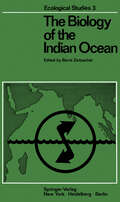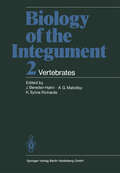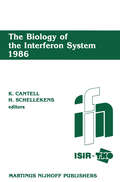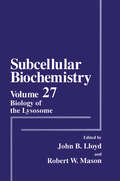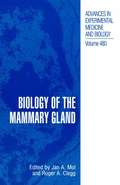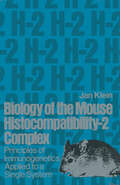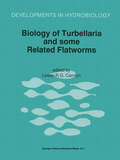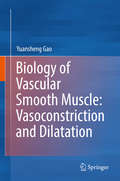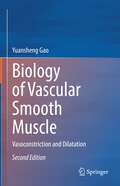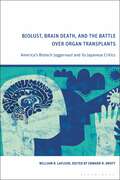- Table View
- List View
The Biology of the Indian Ocean (Ecological Studies #3)
by S. A. GerlachThis volume contains the proceedings of a Symposium held at the University of Kiel, Germany, from 31 March to 6 April, 1971. The Symposium was organized by the Scientific Committee on Oceanic Research (SCOR) and the Marine Productivity section of the International Biological Programme (IBPIPM) with the assistance of the United Nations Educational, Scientific and Cultural Organization (UNESCO), the Food and Agriculture Organization (FAO), and the International Association of Biological Oceanography (IABO). The aim of the Symposium was to summarize present knowledge of the biology of the Indian Ocean. Twenty-two presentations by invited speakers reviewed the research work carried out during the International Indian Ocean Expedition (lIOE) 1959 -1965, the first cooperative project coordinated by the Intergovernmental Oceanographic Commission (IOC). In addition, reports were presented of postexpedition examination of material and of more recent investigations relevant to the aims of the lIOE. In keeping with the aims of "Ecological Studies", the present volume contains much new information and some synthesis, all directed towards obtaining an understanding of the functioning and organization of the ecosystem of the Indian Ocean. The plan of the Symposium was to present the relevant meteorological, physical, chemical and geological background and to follow this with the various aspects of biological oceanography. Because of the uneven stage of development of the different disciplines, the papers included in this volume vary in their analytical level.
Biology of the Integument: 2 Vertebrates
by J. Bereiter-Hahn A. G. Matoltsy K. S. RichardsThe integument plays an important role in the survival of meta zoans by separating and protecting them from a hostile environ ment. Its function ranges from protection against injury and in fection, participation in the regulation of body temperature and water balance, to respiratory activity, monitoring of the environ ment and production of signals related to behaviour. All these result from specific structural, biochemical and physiological properties of intra-and extracellular components of the integu ment. Thus its characterization can be best accomplished by a multidisciplinary approach with authors specialized in different fields of science. This multi-author book, in two volumes, provides an up-to date survey of the literature. The first volume deals with the integument of invertebrates, the second with that of vertebrates, both organized primarily on a phylum basis. As the level of knowledge on the integument of phyla differs considerably, the information provided is correspondingly either limited or con densed. For some of the smaller groups of invertebrates little information is available, as often only a few electron micrographs are to be found in the literature ; on the other hand, from the large body of knowledge existing for vertebrates, particularly for mammals, no complete overview can be provided, but publica tions giving access to further information have been reviewed critically.
The Biology of the Interferon System 1986: Proceedings of the 1986 ISIR-TNO meeting on the interferon system, 7–12 September 1986, Dipoli Congress Center, Espoo, Finland
by K. Cantell H. SchellekensProceedings of the 1986 ISIR-TNO meeting held at the Dipoli Congress Center, Espoo, Finland, September 7-12, 1986
Biology of the Lysosome: Biology Of The Lysosome (pdf) (Subcellular Biochemistry #27)
by John B. Lloyd Robert W. MasonBiology of the Mammary Gland (Advances in Experimental Medicine and Biology #480)
by Roger A. Clegg John A. MolProceedings of the European Cooperation in the Field of Scientific and Technical Research (COST 825) Symposium on Mammary Gland Biology, held September 16-18, 1999, in Tours, France. It is difficult to overstate the evolutionary and functional significance of mammary tissue in biology. Substantial progress has been made by researchers in various disciplines, particularly over the last fifteen years, towards realizing the potential of this tissue to yield powerful experimental models for morphogenesis and tissue development; for cellular differentiation; for the biosynthesis and secretion of proteins, lipids, small molecules and inorganic salts; and for the coordination and regulation of these processes. More recently, the possibility of exploiting the secretory epithelial cells of mammary tissue as `cell factories' has become a reality and the recombinant production by lactating animals of an increasing number of proteins, valuable both in the pharmaceutical and `nutraceutical' fields, is in progress or under development. Also in this sphere of agricultural production, genetic as well as nutritional technologies are under investigation and exploitation to optimize milk composition for various end-uses - for instance in food process and manufacture. The possibilities of deriving health benefit from the bioactive properties of some of the minor constituents of milk are emerging to counter the highly-publicized negative health impact of excessive consumption of saturated animal fats. In human nutrition and medicine, the mammary gland is both a source of nutrition to the neonate and a potential health threat to the adult female - breast cancer remains the major single cause of female mortality in most developed countries. This volume provides a unique glimpse into our understanding, at the cutting edge of a variety of disciplines, of this versatile and extraordinary tissue, at the birth of the twenty-first century.
Biology of the Microsporidia (Comparative Pathobiology #1)
by Lee A. Bulla Thomas C. ChengThis is the introductory volume of a new series to be issued under our general editorship. With the development of an unpre cedented increase in interest in comparative pathobiology, we are of the opinion and intent that Comparative PathobioZogy should become the focal point for the publication of definitive reviews and the proceedings of significant symposia in this area of modern biomedical science. Although the term is now in common use, the question is still sometimes raised as to what "pathobiology" includes. This broad area of modern biology includes but extends beyond traditional pathology. It also encompasses studies directed at understanding the biology, chemistry, and physics of infectious agents, in cluding how they contact and invade the effected organism; the reactions of hosts to such agents, as well as to abiotic invaders; the ecologic parameters which facilitate infection; and the development of tools essential for the understanding of hast pathogen interactions. In other words, pathobiology is inter disciplinary and incorporates all of those aspects of biology, chemistry, and physics which directly or indirectly permit greater understanding of the nature of infectious and noninfectious diseases and the possible implications of such in biomedicine, agriculture, and environmental science. By "comparative" is meant an analytical and critical evaluation of comparable processes as they apply to all categories of animals, invertebrates as well as poikilothermic and homeothermic verte brates.
Biology of the Mouse Histocompatibility-2 Complex: Principles of Immunogenetics Applied to a Single System
by J. de KleinSomewhere I heard a story of a bridge and a painter. The bridge was enormous and was made all of metal, and the painter's job was to keep it from rusting. He would start at one end and slowly proceed, day by day, month by month, toward the other end, painting the bridge. But no sooner would he finish with the painting than the bridge would begin to rust again. The rust, too, would start at one end and slowly proceed toward the other end, systematically destroying the painter's endeavor. And so the painter would return to where he had started, and begin painting again, slowly proceeding toward the other end of the bridge, always just one step ahead of the rust. And if the story is true, the painter might still be painting that bridge-a modern Sisyphus! During the writing of this book, the story of the painter and his bridge kept coming to mind. The field the book covers has been developing so rapidly that, like the painter, I too had to return to where I had started and fight the rust of obsolescence. But unlike the painter, I had a deadline to meet, which constituted a point of no return. And so, sending off this manuscript, I have no choice but to watch the fruits of my endeavor be overtaken by the rust.
Biology of the Ovary (Developments in Obstetrics and Gynecology #2)
by P. M. Motta and E. S. E. HafezExtensive reviews have been published on the mor aspects, anatomy, ultrastructure, physiology, bio phology, anatomy, and physiology of the mam chemistry, endocrinology, pharmacology, and physiopathology of the mammalian ovary. The malian ovary. However, little attention has been given to the gaps between the physiological, endo contributors, who prepared their chapters metic ulously, are recognized experts in their respective crine and histochemical parameters of the ovary as disciplines and their writings reflect extensive per it relates to clinical aspects. There is a wealth of sonal experience and unpublished data of both publications concerning the biology of the ovary: basic and clinical sciences. Without the assistance of the purpose of this volume is to integrate this information with emphasis on modern concepts in good friends and permission to draw extensively microanatomy, physiology, methodology, clinical from investigations, this volume would not have complications, and therapeutic approaches. An been possible. attempt is made to place fundamental research in Thanks are due to G. F. Franchitto, F. Barberini, clear perspectives. P. Stoops. Lori Rust and J. Squiers for their editorial It is hoped that this volume will fulfil a long skills and for checking the references to the original standing need and serve as an important source for sources. Thanks are particularly due to 1. K. Smith investigators and clinicians concerned with the of Martinus Nijhoff Publishers BV for his excellent physiopathology of the ovaries for years to come. It cooperation during the production of the book.
Biology of the Uterus
by Ralph M. WynnAlmost a quarter of a century has elapsed since Cellular Biology of the Uterus, the predecessor of the present volume, was planned. During that period, especially in the decade since the publication of the last edition of Biology of the Uterus, new information in the field has been so voluminous as to require major revisions of most of the chapters, the addition of several new chapters, and the collaboration of a second editor to facilitate the selection of appropriate experts as authors. As in prior editions, a balance has been struck between classical biology and modem biochemistry and biophysics. The inclusion of basic histological and embryo logical information provides a necessary, though often lacking, background for the protein chemist and molecular biologist and a bridge between the cell biologist and clinician. Thus, major practical problems in human reproduction, such as the genesis of endometrial carcinoma and the cause of the initiation of labor, may be approached on a firm scientific footing. The current edition deals primarily with the biology of the uterus itself (comparative and human) rather than placentation or pregnancy and thus is a synthesis of data derived from many techniques, both conventional and modem. As it is clearly beyond the competence of anyone scientist to prepare such a text on the basis of personal knowledge and experience, the aid of 22 distinguished scientists was enlisted.
The Biology of Trypanosomes (Current Topics in Microbiology and Immunology #117)
by Leslie HudsonAfrican and South American trypanosomiases are notable features of clinical and veterinary practice in their respective endemic areas and, as such, are of considerable economic importance. Scientifically, however, their importance ex tends beyond their clinical significance, as the trypano somes are intriguing and easily manipulated models for the study of the control of gene expression, membrane chemistry, proliferation and differentiation. It is clear from the scientific press that the rate of advance has "hotted" up in these areas of trypanosome research over the past 5 years and so a single-topic volume within the scope of the present series seemed timely. As ever, the final admix ture of review topics was a compromise between what was appropriate and what was available - fortunately with the former in vast excess. I should like to highlight two omissions, made for en tirely different reasons. The first is a detailed treatment of the molecular biology of the variant surface glycopro teins of the African trypanosomes (in particular Trypano soma brucei and T. equiperdum). This topic has been the subject of several reviews, for example, BORST and CROSS (1982)1 and TURNER (1982)2, and so was excluded from the present volume. The second omission is a review of the first-class work on genetic recombination from the group of Dr. Leo Jenni at the Schweizerisches Tropeninsti tut, Basel. This group has used isoenzyme markers to show that T.
Biology of Tumors: Surfaces, Immunology And Comparative Pathology (Cancer, a compresensive treatise #4)
by Frederick F. BeckerAs was shown in the first two volumes of this series, great strides have been made in identifying many of the agents or classes of substances responsible for carcinogenesis and in delineating their interactions with the cell. Clearly, the aim of such studies is that, once identified, these agents can be eliminated from the environment. Yet, despite these advances and the elimination of some important carcinogenic agents, one major problem exists. It is a constant monitor of all oncologic study and diminishes the importance of every experiment and of every clinical observation. As we noted earlier, that problem is our inability to define the malignant cell. It is through studies of the fundamental biology of tumors that we seek this definition. A vast amount of information has been gathered which describes what this cell does and-to a lesser extent-how it does it. But the why evades us. We have been unable to define the malignant cell, save in broad terms by comparing it to its normal counterpart. The major problem appears to be that the malignant cell does so much. It is a chimera, mystifyingly composed of normal activities and structures, of phenotypic schizophrenia with embryonic, fetal, and adult charac teristics and, occasionally, a hint of an unclassifiable capacity unique to malignant cells.
The Biology of Tumors (Pezcoller Foundation Symposia #9)
by Enrico Mihich Carlo CroceThe Ninth Annual Pezcoller Symposium entitled "The Biology of Tumors" was held in Rovereto, Italy, June 4-7, 1997. It focused on the genetic mechanisms underlying het erogeneity of tumor cell populations and tumor cell differentiation, on interactions be tween tumor cells and cells of host defenses, and the mechanisms of angiogenesis. With presentations at the cutting edge of progress and stimulating discussions, this symposium addressed issues related to phenomena concerned with cell regulation and cell interactions as determined by activated genes through the appropriate and timely media tion of gene products. Important methodologies that would allow scientists to measure dif ferentially genes and gene products and thus validate many of the mechanisms of control currently proposed were considered, as were the molecular basis of tumor recognition by the immune system, interactions between cells and molecular mechanisms of cell regula tion as they are affected by or implemented through these interactions. The molecular and cellular mechanisms of tumor vascularization were also discussed. It was recognized that angiogenesis provides a potential site of therapeutic intervention and this makes it even more important to understand the mechanisms underlying it. We wish to thank the participants in the symposium for their substantial contribu tions and their participation in the spirited discussions that followed. We would also like to thank Drs.
Biology of Turbellaria and some Related Flatworms: Proceedings of the Seventh International Symposium on the Biology of the Turbellaria, held at Åbo/Turku, Finland, 17–22 June 1993 (Developments in Hydrobiology #108)
by Lester R. G. CannonTurbellaria, the mainly free-living flatworms, and some of their parasitic relatives, are among the simplest of the metazoa and, as such, provide ideal models for a wide range of fundamental studies. The 60 contributions to Biology of Turbellaria and some Related Flatworms cover taxonomy and phylogeny, biogeography and genetics, ecology and behaviour, Anatomy and ultrastructure, development and regeneration, genes and sequences, and neurophysiology. Biology of Turbellaria and some Related Flatworms is the most recent compilation in the series published in Hydrobiologia since 1981, covering research on these flatworms assembled by the world's leading authorities on the group. Audience: These papers present the advanced student and serious researcher with up to date information on an important, but often neglected group whose place in the animal kingdom demands greater attention.
Biology of Vascular Smooth Muscle: Vasoconstriction and Dilatation
by Yuansheng GaoThis book provides a concise yet comprehensive review of the morphological, biochemical, electrical, mechanical, and metabolic properties of vascular smooth muscle, the regulation of vascular activities and the intracellular signaling involved. It particularly focuses on recently identified vasoactive agents, enzymes and transduction mechanisms. It also discusses the latest findings in the regulation of cerebral, coronary and pulmonary circulation as well as vascular activity under hypoxia and ageing. The contraction and dilatation activities of vasculature are of fundamental importance for maintaining circulation homeostasis and adapting physiological changes. Over the last four decades, there have been significant advances in our understanding of the biochemical, structural, genetic, physiological, and pharmacological aspects of vascular activity regulation, and these insights into the responsiveness of blood vessels under normal and pathophysiological conditions help to provide valuable weapons in the fight vascular diseases. The book is of interest to researchers and graduate students, both in basic research and in clinic settings, in the field of vascular biology.
Biology of Vascular Smooth Muscle: Vasoconstriction and Dilatation
by Yuansheng GaoThis book provides a concise yet comprehensive review of the morphological, biochemical, electrical, mechanical, and metabolic properties of vascular smooth muscle, the regulation of vascular activities and the intracellular signaling involved. It particularly focuses on newly identified vasoactive agents, enzymes and transduction mechanisms. It also discusses the latest findings in the regulation of cerebral, coronary and pulmonary circulation as well as vascular activity under hypoxia and ageing. The second edition intends to update the contents of the first edition with the latest achievements in the regulation of vascular activities from biochemical, structural, genetic, physiological, and pharmacological aspects. In addition, two new chapters related to microRNA and extracellular vesicles have been added to reflect their newly discovered important roles in vascular activities. The contraction and dilatation activities of vasculature are of fundamental importance for maintaining circulation homeostasis and adapting to physiological changes. Over the last four decades, there have been significant advances in our understanding of the biochemical, structural, genetic, physiological, and pharmacological aspects of vascular activity regulation, and these insights into the responsiveness of blood vessels under normal and pathophysiological conditions help to provide valuable weapons in the fight vascular diseases. The book is of interest to researchers and graduate students, both in basic research and in clinic settings, in the field of vascular biology.
Biology of Women’s Heart Health (Advances in Biochemistry in Health and Disease #26)
by Lorrie Kirshenbaum Inna Rabinovich-NikitinCardiovascular disease (CVD) is the leading cause of morbidity and mortality in women and men worldwide and represents a major financial burden to world health care systems. Importantly, CVD has eclipsed cancer as the leading cause of death for women globally. Through advancements in research and clinical testing, the symptoms and risk factors for CVD have been well established for men, but not for women. Consequently, there is an immediate need for new innovative research that will bridge this gap and allow for improved early diagnosis and treatment of CVD in women. This book will serve as a guide for health care providers to better understand the physiological, biochemical, and genetic differences in heart disease in women with the goal of providing improved education, awareness and treatment of cardiovascular disease in women. The book will cover topics such as: sex dependent clinical outcomes of cardiovascular disease, cardiac protection by estrogen, cardiac health during menopause, cardiac rehabilitation programs, fitness and exercise, cardio-oncology, shift work and the CVD risk, and pregnancy related CVD.
Bioluminescent Imaging: Methods and Protocols (Methods in Molecular Biology #1098)
by Christian E. BadrBioluminescent Imaging: Methods and Protocols distills a wide range of techniques that use bioluminescence imaging as a tool for visualizing and tracking various biological processes. Covering diverse fields such as cellular and molecular biology, oncology, neurology, infectious diseases, immunology, and others, the detailed chapters of this volume are arranged by topic and describe practical procedures and applications of different bioluminescent reporters, from photoproteins (Aequorin) to bacterial luciferases as well as other secreted (such as Gaussia) and non-secreted luciferases (such as Firefly). Written in the highly successful Methods in Molecular Biology series format, chapters include introductions to their respective topics, lists of the necessary materials and reagents, step-by-step, readily reproducible laboratory protocols, and expert tips for troubleshooting and avoiding known pitfalls.Authoritative and cutting-edge, Bioluminescent Imaging: Methods and Protocols aims to provide diverse and comprehensive techniques to researchers interested in implementing bioluminescence-based imaging in their laboratory, regardless of their previous level of experience with such methodologies.
Bioluminescent Imaging: Methods and Protocols (Methods in Molecular Biology #2081)
by Steven RippThis volume provides detailed protocols and methodologies required to perform bioluminescent imaging in multiple stages, enabling the reader to integrate this technology into their laboratory-based imaging experiments. Written in the highly successful Methods in Molecular Biology series format, chapters include introductions to their respective topics, lists of the necessary materials and reagents, step-by-step, readily reproducible laboratory protocols, and tips on troubleshooting and avoiding known pitfalls. Authoritative and cutting-edge, Bioluminescent Imaging: Methods and Protocols to ensure successful results in the further study of this vital field.
Bioluminescent Microbial Biosensors: Design, Construction, and Implementation
by Gérald Thouand Robert S. MarksThis book describes the design and the use of bioluminescent biosensors. It introduces beginners and experienced researchers starting in the microbiological biosensor domain to the practical aspects of building a luminescent microbial biosensor. It is also a source of information about other applications that use microbial cells. Each chapter focus
Biolust, Brain Death, and the Battle Over Organ Transplants: America’s Biotech Juggernaut and its Japanese Critics
by William R. LaFleurWilliam LaFleur (1936-2010), an eminent scholar of Japanese studies, left behind a substantial number of influential publications, as well as several unpublished works. The most significant of these examines debates concerning the practice of organ transplantation in Japan and the United States, and is published here for the first time.This provocative book challenges the North American medical and bioethical consensus that considers the transplantation of organs from brain dead donors as an unalloyed good. It joins a growing chorus of voices that question the assumption that brain death can be equated facilely with death. It provides a deep investigation of debates in Japan, introducing numerous Japanese bioethicists whose work has never been treated in English. It also provides a history of similar debates in the United States, problematizing the commonly held view that the American public was quick and eager to accept the redefinition of death.A work of intellectual and social history, this book also directly engages with questions that grow ever more relevant as the technologies we develop to extend life continue to advance. While the benefits of these technologies are obvious, their costs are often more difficult to articulate. Calling attention to the risks associated with our current biotech trajectory, LaFleur stakes out a highly original position that does not fall neatly onto either side of contemporary US ideological divides.
Biolust, Brain Death, and the Battle Over Organ Transplants: America’s Biotech Juggernaut and its Japanese Critics
by William R. LaFleurWilliam LaFleur (1936-2010), an eminent scholar of Japanese studies, left behind a substantial number of influential publications, as well as several unpublished works. The most significant of these examines debates concerning the practice of organ transplantation in Japan and the United States, and is published here for the first time.This provocative book challenges the North American medical and bioethical consensus that considers the transplantation of organs from brain dead donors as an unalloyed good. It joins a growing chorus of voices that question the assumption that brain death can be equated facilely with death. It provides a deep investigation of debates in Japan, introducing numerous Japanese bioethicists whose work has never been treated in English. It also provides a history of similar debates in the United States, problematizing the commonly held view that the American public was quick and eager to accept the redefinition of death.A work of intellectual and social history, this book also directly engages with questions that grow ever more relevant as the technologies we develop to extend life continue to advance. While the benefits of these technologies are obvious, their costs are often more difficult to articulate. Calling attention to the risks associated with our current biotech trajectory, LaFleur stakes out a highly original position that does not fall neatly onto either side of contemporary US ideological divides.
Biomagnetic Stimulation: Principles And Applications Of Biomagnetic Stimulation And Imaging
by Shoogo UenoThe International Symposium on Biomagnetic Stimulation was held on July 15, 1991 at the International Hall of the Hakozaki campus of Kyushu University in Fukuoka, Japan. It was a satellite symposium to the World Congress on Medical Physics and Biomedical Engi neering in Kyoto, which was held July 7-11, 1991. Successful magnetic stimulation of the human brain was first reported by Dr. Anthony Barker and his group at the University of Sheffield in the United Kingdom, in May, 1985. Of course, magnetic nerve stimulation had been studied and reported before then, but Dr. of successful stimulation of the brain made a strong impact on the scientific Barker's reports community. Since then, magnetic nerve stimulation has been widely and rapidly investigated by many groups throughout the world. This symposium focused mostly on magnetic brain stimulation. Magnetic resonance imaging has become an indispensable technique for clinical diagno sis and medical science. The most advanced MRI techniques, such as echo planar imaging, have the potential hazard of stimulating nerve tissues due to the rapid change of gradient mag netic fields. Potential risks of MRI, including problems with gradient magnetic fields, were discussed at the symposium. Magnetic stimulation of the heart was also discussed.
Biomagnetics: Principles and Applications of Biomagnetic Stimulation and Imaging
by Shoogo Ueno Masaki SekinoDiscover the Most Advanced Technologies in Biomagnetics Co-edited by Professor Ueno, a leader in the biomagnetics field for over 40 years, Biomagnetics: Principles and Applications of Biomagnetic Stimulation and Imaging explains the physical principles of biomagnetic stimulation and imaging and explores applications of the latest techniques in neuroscience, clinical medicine, and healthcare. The book shows you how the techniques are used in hospitals and why they are so promising. A brief overview of recent research trends in biomagnetics provides you with an up-to-date, informative guide to explore further in this field. The book focuses on three important areas: Magnetic nerve stimulation and transcranial magnetic stimulation Biomagnetic measurements and imaging of the human brain by advanced technologies of magnetoencephalography and MRI Biomagnetic approaches to potential treatments of cancers, pains, and other neurological and psychiatric diseases, such as Alzheimer’s disease and depression These core areas of the book were developed from the editors’ prestigious graduate-level courses in biomedical engineering. The text also discusses biomagnetic approaches to advanced medicine, including regenerative and rehabilitation medicine.
Biomanagement of Metal-Contaminated Soils (Environmental Pollution #20)
by Mohammad Saghir Khan, Almas Zaidi, Reeta Goel and Javed MusarratHeavy-metal contamination is one of the world's major environmental problems, posing significant risks to agro-ecosystems. Conventional technologies employed for heavy-metal remediation have often been expensive and disruptive. This book provides comprehensive, state-of-the-art coverage of the natural, sustainable alternatives that use a wide range of biological materials in the removal/detoxification of heavy metals, consequently leading to the improvement of crops in these soils. Novel, environmentally friendly and inexpensive solutions are presented based on a sound understanding of metal contamination and the roles of plants and microbes in the management of these toxic soils. Written by worldwide experts, the book provides not only the necessary scientific background but also addresses the challenging questions that require special attention in order to better understand metal toxicity in soils and its management through bioremediation.
Biomanufacturing
by Chander Prakash Sunpreet Singh Rupinder Singh Seeram Ramakrishna B. S. Pabla Sanjeev Puri M. S. UddinCurrent Trends in Biomanufacturing focuses on cutting-edge research regarding the design, fabrication, assembly, and measurement of bio-elements into structures, devices, and systems.The field of biomaterial and biomanufacturing is growing exponentially in order to meet the increasing demands of for artificial joints, organs and bone-fixation devices. Rapid advances in the biological sciences and engineering are leading to newer and viable resources, methods and techniques that may providing better quality of life and more affordable health care services.The book covers the broad aspects of biomanufacturing, including:synthesis of biomaterials;implant coating techniques;spark plasma sintering;microwave processing; andcladding, powder metallurgy and electrospinning.The contributors illustrate the recent trends of biomanufacturing, highlighting the important aspects of biomaterial synthesis, and their use as feedstock of fabrication technologies and their characterization, along with their clinical practices. Current Trends in Biomanufacturing updates researchers and scientists the novelties and techniques of the field, as it summarises numerous aspects of biomanufacturing, including synthesis of biomaterials, fabrication of biomedical structures, their in-vivo/ in-vitro, mechanical analysis and associated ISO standards.
